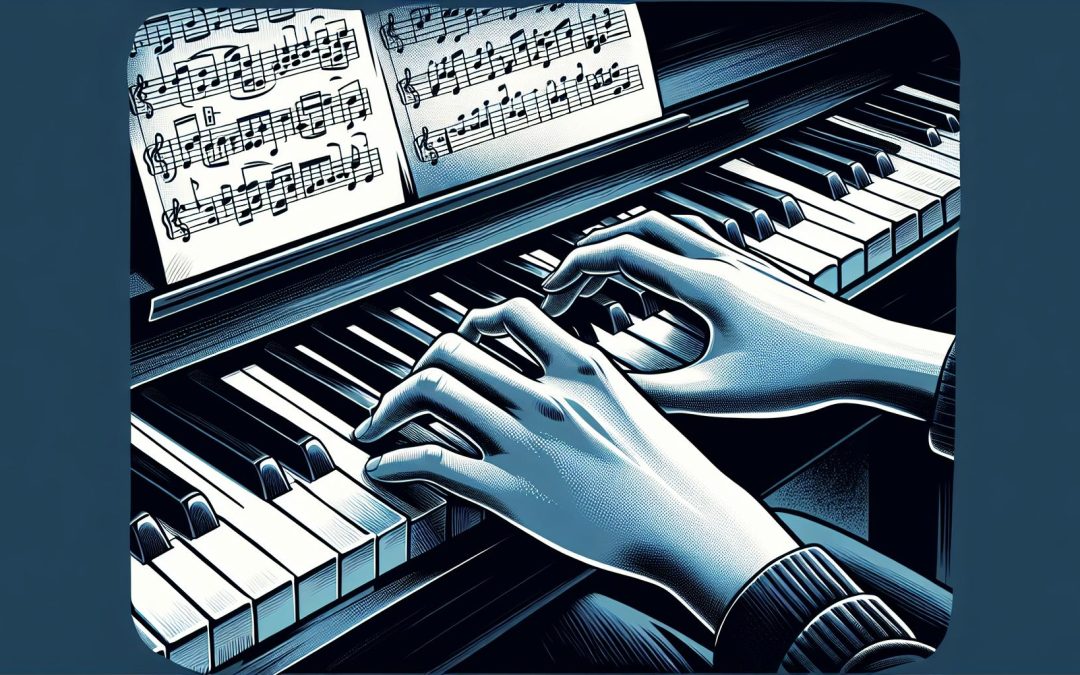The blues, with its soulful melodies and deep emotional expression, has a timeless appeal that resonates with many. For those looking to dive into this genre on the keyboard, starting with simple songs is a fantastic way to get those fingers moving. The beauty of blues music lies in its simplicity and the raw emotion it conveys, making it a perfect starting point for beginners.
Luckily, there are plenty of blues classics that are not only easy to learn but also incredibly fun to play. These songs serve as the perfect introduction to blues music, allowing budding musicians to quickly pick up basic chords and rhythms. So, whether you're a complete novice or someone looking to expand your musical repertoire, these simple blues songs are sure to get you grooving on the keyboard in no time.
Understanding the Basics of Blues Music
Before diving into the keyboard and trying out blues tunes, it's essential to grasp the foundations of blues music. This genre, born from the soulful expressions of African American communities in the Deep South of the United States, thrives on its simplicity and emotional depth. Blues music often tells a story, reflecting the joys, sorrows, and everyday struggles of life.
At the core of blues music lies the 12-bar blues. It's a chord progression that's become the backbone of countless blues songs. This pattern is straightforward yet incredibly versatile, offering a canvas on which musicians can paint their emotional narratives. The 12-bar blues typically follows a specific structure: the I, IV, and V chords of any key. Understanding this progression is crucial for anyone looking to play blues music, as it provides a solid foundation from which to explore and experiment.
Another hallmark of blues music is its rhythm. The shuffle rhythm, characterized by a swung note feel, gives blues its distinctive, foot-tapping quality. This rhythm can transform a simple chord progression into something that feels alive, evoking the heart and soul of blues music.
For keyboard players, mastering the blues scale is a must. The blues scale adds nuance and color to melodies, enabling musicians to convey a wide range of emotions through their playing. This scale is a modification of the minor pentatonic scale, with an added "blue note" that gives the scale its distinctive sound.
Easy Blues Songs to Start With on Keyboard
Starting with simple blues songs on the keyboard can be both rewarding and fun. Here are a few classics that are perfect for beginners:
- "Hoochie Coochie Man" by Muddy Waters: This song offers a great introduction to the 12-bar blues progression.
- "Saint Louis Blues" by W.C. Handy: Ideal for those looking to practice the blues scale and explore its emotional depth.
- "The Thrill is Gone" by B.B. King: A slower blues tune that allows for practice with expressiveness and dynamics.
Each of these songs embodies the essence of blues music, letting beginners immerse themselves in its rich history and emotional expressiveness while developing their keyboard skills.
Benefits of Playing Simple Blues Songs on Keyboard

Embarking on the journey of learning blues songs on the keyboard isn't just about mastering a new genre; it's a voyage that bears a multitude of benefits, subtly enhancing both musical skills and emotional well-being. Simple blues songs, with their straightforward structures and soulful melodies, serve as an excellent starting point for novices and an enjoyable practice for seasoned players.
Musical Foundation
Firstly, delving into blues songs assists in solidifying one's musical foundation. The repetitive 12-bar blues progression is a cornerstone of many blues pieces and provides a clear structure for understanding song composition. It's an invaluable tool for developing a sense of timing and form. Moreover, the blues scale introduces keyboard players to expressive note combinations that are quintessential to the genre. This scale is crucial for improvisation, a skill highly valued in blues and beyond.
Emotional Expression
The blues is renowned for its emotional depth. Playing blues songs allows musicians to explore and express a wide range of feelings, from melancholy to joy. This emotional engagement not only enhances the performance but also contributes to the player's emotional intelligence. Learning to convey emotions through music is a powerful tool for personal expression and connection with others.
Coordination and Rhythm
Blues music is rhythmically rich, often featuring syncopated patterns and the characteristic shuffle rhythm. Practicing these elements on the keyboard improves hand coordination and rhythmical understanding. These skills are transferable to other music genres and are fundamental for any musician aspiring to be versatile and dynamic.
Repertoire and Versatility
Incorporating blues songs into one's repertoire expands musical knowledge and versatility. Given the blues' influence on many popular genres, such as rock and jazz, understanding blues progression and style enhances a player’s ability to tackle a diverse array of songs. This versatility is not only rewarding but also increases opportunities for collaboration and performance across different musical settings.
Creativity and Improvisation
Blues music is synonymous with improvisation. Simple blues songs provide the perfect backdrop for experimenting with improvisation. This practice encourages creativity, as musicians explore new melodies and harmonies within the framework of the blues scale and progression. Improvisation skills are valuable not only in blues but in all musical endeavors, fostering a deeper musical understanding and the ability to express oneself uniquely.
Selection Criteria for Simple Blues Songs

When embarking on the journey of playing blues on the keyboard, choosing the right songs is crucial for beginners. The selection process involves a few key criteria that ensure the songs are not only enjoyable but also enhance the player's musical journey.
Complexity of Chords
One of the first aspects to consider is the complexity of the chords. Simple blues songs often rely on the traditional 12-bar blues progression, which utilizes a trio of basic chords. This simplicity allows beginners to grasp the fundamental structure of blues music without feeling overwhelmed. Songs that stick to major and dominant seventh chords are ideal starting points, as they offer a quintessential blues sound while remaining accessible to novices.
Rhythm and Tempo
Another essential criterion is the rhythm and tempo of the song. Blues music is known for its distinctive shuffle and swing rhythms, which can be a new territory for those accustomed to straight rhythms. Beginners should look for songs with a moderate tempo, providing ample space to focus on the nuances of blues timing without the added pressure of keeping up with fast-paced tracks.
Melodic Complexity
The melodic complexity of a song is also a vital consideration. Simple melodies that use the blues scale are preferable for those new to the genre. These melodies often feature repetitive patterns and phrases, making them easier to learn by ear and memorize. Songs that emphasize melodic simplicity allow beginners to experiment with expressive techniques, like bends and slides, without the complexity of intricate melodies.
Lyrics and Theme
While instrumental skills are paramount, the lyrics and theme of the song can also impact the learning experience. Choosing songs with relatable or compelling stories can make the practice more engaging. The emotional depth of blues music is one of its hallmarks, and playing songs that resonate on a personal level can enhance the emotional expression in performance.
Availability of Resources
Lastly, the availability of resources such as sheet music, tutorials, and backing tracks can influence song selection. Beginners benefit greatly from accessible learning materials that provide guidance and support throughout the learning process. Songs with readily available resources ensure that beginners can practice effectively and develop their skills with confidence.
Top 5 Simple Blues Songs to Play on Keyboard

Navigating through the vast sea of blues music can seem overwhelming for beginners looking to make their mark on the keyboard. However, certain tracks stand out for their simplicity, emotional depth, and opportunity for learning. Below are five blues songs that embody the core elements discussed previously, offering an ideal starting point for keyboard novices.
1. "C Jam Blues" by Duke Ellington
- Chord Simplicity: Primarily revolves around two major chords.
- Rhythmic Foundation: A straightforward melody that eases players into blues rhythm.
This song is a testament to the power of melody and rhythm, even in their simplest forms. It’s perfect for those just starting out on the keyboard, allowing players to focus on the feel of the blues scale without the complexity of intricate chord changes.
2. "The Thrill Is Gone" by B.B. King
In "The Thrill Is Gone," beginners find a blend of emotive lyrics and a melody that’s compelling yet manageable. This track introduces minor chords and dominant sevenths in a way that’s accessible to novices, reinforcing the importance of emotional expression in blues music.
3. "Sweet Home Chicago" by Robert Johnson
- Tempo: Moderate, making it ideal for practicing timing.
- Chord Progression: A mix of dominant seventh chords that are fundamental in blues.
A staple in the blues repertoire, "Sweet Home Chicago" offers a lively introduction to the 12-bar blues structure. Its upbeat tempo and joyous melody make practicing feel less like a chore and more like fun.
4. "Ain't No Sunshine" by Bill Withers
Though slightly veering towards soul, "Ain't No Sunshine" provides an approachable platform for exploring moody dynamics and soulful expressions on the keyboard. The repetitive melodic structure helps beginners focus on expression rather than being bogged down by technicality.
5. "Piano Man" by Billy Joel
- Harmonica Intro: Offers a unique intro before diving into piano chords.
- Storytelling: Perfect for understanding the narrative aspect of blues.
While not a traditional blues piece, "Piano Man" incorporates bluesy elements that are beneficial for keyboard beginners. Its storytelling aspect and harmonica introduction provide a different texture for players looking to explore diversity in their practice.
Conclusion
Diving into the world of blues on the keyboard doesn't have to be daunting. With the songs outlined, beginners have a perfect starting point. Each piece not only hones technical skills but also invites players into the expressive depth of blues music. From Duke Ellington's rhythmic bounce to Bill Withers' soulful depths, there's a rich spectrum of emotion and technique to explore. And while "Piano Man" might stretch the traditional blues boundary, it's a reminder that music is about storytelling and feeling, as much as it is about chords and tempo. So go ahead, let these songs be your guide into the expressive world of blues on the keyboard.
Harlan Kilstein began playing piano during covid with no piano background at all. He taught himself how to play learning what to do and what not to do.
Today he's an advanced intermediate player and can help you grow in your skills because he learned all this on his own.








